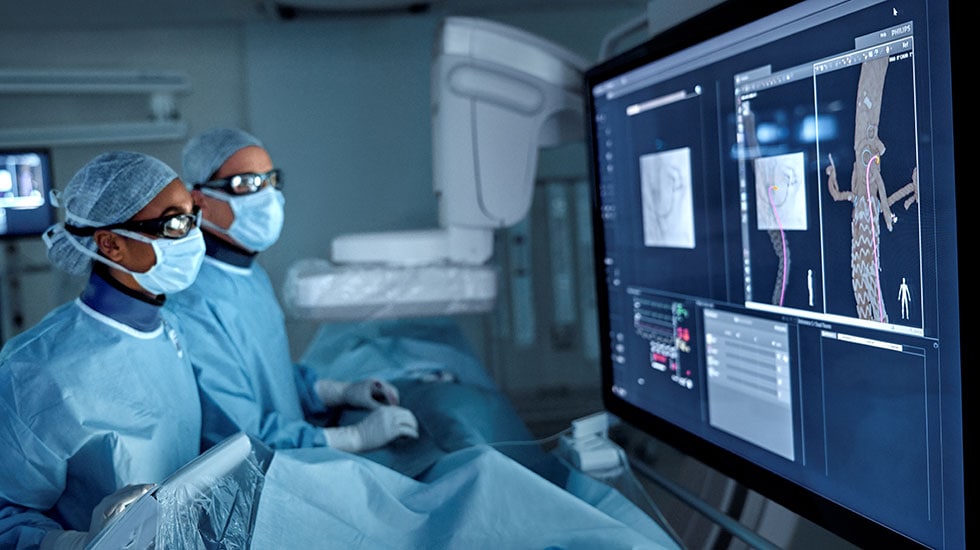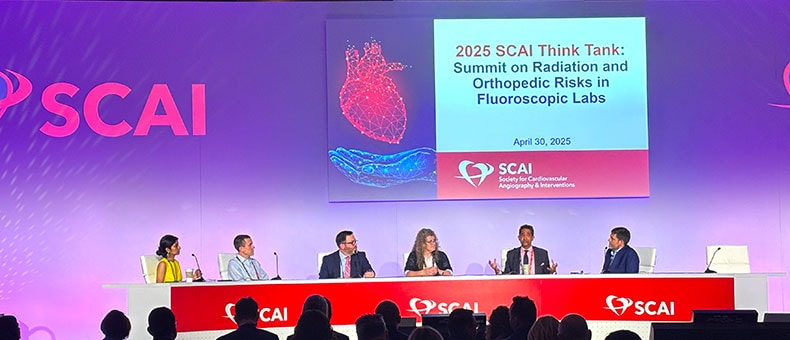Engineering safety at the source: How Philips is reducing X-ray exposure to protect patients and staff
May 20, 2025 | 3 minute read
Today, medical imaging is one of the cornerstones of modern medicine. Its history started in 1895 with the discovery of X-rays, and ever since X-ray imaging has transformed healthcare. From enabling diagnoses through diagnostic X-ray and Computed Tomography (CT) imaging to guiding targeted treatments. Interventional X-ray imaging (e.g., X-ray fluoroscopy and angiography), has become the invisible backbone of image-guided therapy, from enabling minimally invasive cardiac and neurovascular procedures to guiding complex aortic and oncology interventions. But with these powerful capabilities comes a growing imperative: to protect patients and medical teams from radiation exposure and the physical burdens of protective equipment.

Globally, studies have shown that interventional physicians and cath lab personnel face significant occupational hazards. Up to 66% [1] report orthopedic injuries related to prolonged use of the protective lead aprons, while premature cataracts and even elevated cancer risks have been reported. Radiation protection is gaining particular importance amongst female physicians, trainees, nurses and technologists. Radiation exposure in interventional labs presents unique reproductive health concerns, particularly for women. Despite protective measures, many female clinicians still report exposure during pregnancy, often without access to timely radiation data or clear institutional policies.
These concerns took center stage at the SCAI 2025 Scientific Sessions meeting in Washington DC (US) in early May, where interventional radiologist Dr. Atul Gupta, Chief Medical Officer for Diagnosis & Treatment at Philips, represented industry during a five-hour multi-society summit on fluoroscopic lab safety. The session, attended by medical society leaders and specialists across interventional cardiology, radiology, neuro, surgery, electrophysiology hospital procurement and echocardiography. In addition, hospital C-suite, procurement, radiation safety officers, along with government liaisons, culminated in the release of a new Consensus Statement on Enhanced Radiation Protection—now open for public comment.

The statement calls for mandatory implementation of radiation protection devices and strategies to meet ALARA ("As Low As Reasonably Achievable") standards. This includes real-time dosimetry, ergonomic solutions to mitigate orthopedic injuries, and broader use of engineering controls to further reduce X-ray exposure during procedures.
Philips: Proven leadership in X-ray dose reduction
Dr. Gupta used the SCAI platform to underscore that Philips has not only been listening— it has been pioneering and leading in new technologies to reduce X-ray exposure by addressing the source. “Radiation dose reduction is not a new topic for us,” he explained. “It’s been part of our DNA for many decades, driven by science, clinical evidence, and collaboration with the physicians and staff who use our systems.”
Philips has taken a comprehensive, system-wide approach to radiation safety—developing and integrating a suite of technologies that work together to reduce dose, improve workflow, and maintain clinical confidence in diagnosis and treatment. Dr. Gupta pointed to innovations such as Azurion with ClarityIQ, which is clinically proven to reduce patient radiation dose by between 23% and 83% across different procedures, based on 37 peer-reviewed studies involving over 19,000 patients. He also highlighted LumiGuide with FORS technology, which uses light instead of X-ray for radiation-free 3D device visualization. This technology has already been used in more than 1,600 procedures to date. Other examples include DoseAware, a real-time dosimetry solution that helps reduce staff exposure by making radiation levels visible during procedures, and EchoNavigator which enables real-time fusion of ultrasound and fluoroscopy for structural heart interventions.
These advances—and many more—are part of a broader system-wide strategy to engineer safety at the source—supplemented by emerging technologies like endovascular robotics and AI-enhanced ultrasound guidance, which aim to minimize physical strain and reduce the need for live fluoroscopy.
A vision rooted in collaboration and evidence
As a pioneer and innovator in X-ray dose reduction, Philips fully supports the growing momentum around radiation safety. The company supports enhanced regulation, cross-specialty collaboration, and the call for system-level change. Its longstanding approach—grounded in engineering at the source, validated through peer-reviewed data, and shaped in partnership with clinical leaders.
As new policies emerge and as hospitals evaluate how to future-proof their interventional labs, Philips offers more than equipment. It offers an innovation roadmap—modular, scalable, and clinically proven—to create a working environment that protects both the patient on the table and the team around it.
“If we can save a patient’s life,” Dr. Gupta concluded, “we should also be able to protect the clinicians treating them. That’s not just an engineering goal— that is part of Philips’ approach to put the patient and clinician at the center of everything we do.”
Sources [1] 2023 survey conducted by the Society for Cardiovascular Angiography and Interventions (SCAI)
[2] Pubmed: Transradial versus Transfemoral Access for Hepatic Chemoembolization: Intrapatient Prospective Single-Center Study








